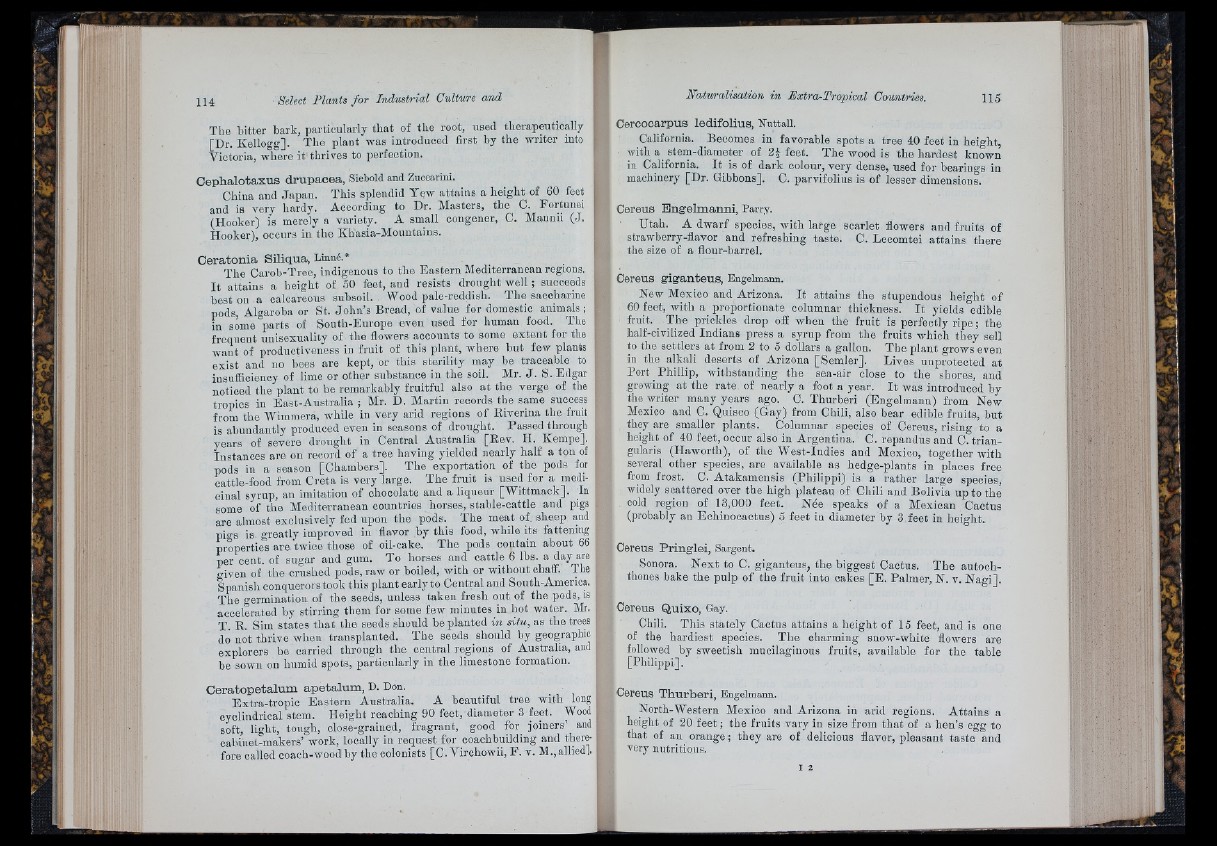
The bitter bark, particularly th a t of tlie root, used therapeutically
[Dr. Kellogg]. The plant was introduced first by the writer into
Victoria, where it thrives to perfection.
C e p h a lo t a x u s d r u p á c e a , Siebold and Zuccarini.
China and Japan. This splendid Yew attains a height of 60 feet
and is very hardy. According to Dr. Masters, the C. Fortunei
(Hooker) is merely a variety. A small congener, C. Mannii (J.
Hooker), occurs in the Khasia-Mountains.
C e r a to n i a S iliq u a , Linné.*
The Carob-Tree, indigenous to the Eastern Mediterranean regions.
I t attains a height of 50 feet, and resists drought well ; succeeds
best oil a calcareous subsoil. Wood pale-reddish. The saccharine
pods, Algaroba or St. Jo h n ’s Bread, of value for domestic animals ;
in someV^'t® South-Europe even used for human food. The
frequent unisexuality of the flowers accounts to some extent for the
want of productiveness in fruit of this plant, where but few plants
exist and no bees are kept, or this sterility may be traceable to
insufficiency of lime or other substance in the soil. Mr. J . S. Edgar
noticed the plant to be remarkably fruitful also a t the verge of the
tropics in East-Australia ; Mr. D. Martin records the same success
from the Wimmera, wliile in very arid regions of Riverina the fruit
is abundantly produced even in seasons of drought. Passed through
years of severe drought iu Central Australia [Rev. H. Kempe].
Instauces are on record of a tree having yielded nearly half a ton of
pods in a season [Chambers]. The exportation of the pods for
cattle-food from Creta is very large. The fruit is used for a medicinal
syrup, an imitation of chocolate and a liqueur [Wittmack]. In
some of the Mediterranean countries horses, stable-cattle and pigs
are almost exclusively fed upon the pods._ The meat of. sheep and
pic’s is greatly improved in flavor by this food, while its fattening
properties are twice those of oil-cake. The pods contain about 66
per cent, of sugar and gum. To horses and cattle 6 lbs. a day are
given of the crushed pods, raw or boiled, with or without chaff. The
Spanisli conquerors took this plant early to Central and South-America.
The germination of the seeds, unless taken fresh out of the pods, is
accelerated by stirring them for some few minutes in hot water. Mr.
T. B. Sim states th a t the seeds should be planted in situ, as the trees
do n it thrive when transplanted. The seeds should by geographic
explorers be carried through the central regions of Australia, and
he sown on humid spots, particularly in the limestone formation.
C e r a to p e t a lu m a p e t a lu m , D. Don.
Extra-tropic Eastern Australia. A beautiful tree with long
cyolindrical stem. Height reaching 90 feet, diameter 3 feet. Wood
soft, light, tough, close-grained, fragrant, good for joiners’ and
cabinet-makers’ work, locally in request for coachbuilding and therefore
called coach-wood by the colonists [C. Virchowii, F. v. M., allied],
C e rc o c a rp u s le d ifo liu s , Nuttall.
California. Beoomes in favorable spots a tree 40 feet in height,
with a, stem-diameter of 2 | feet. The wood is the hardest known
in California. I t is of dark colour, very dense, used for bearings in
machinery [Dr. Gibbous], C. parvifolius is of lesser dimensions.
C ereus E n g e lm a n n i, Parry.
Utah. A dwarf species, with large scarlet flowers and fruits of
strawberry-flavor and refreshing taste. C. Lecomtei attains there
the size of a flour-barrel.
Ce reu s g ig a n t e u s , Engelmann.
New Mexico and Arizona. I t attains the stupendous height of
■60 feet, with a proportionate columnar thickness. I t yields edible
fruit. The prickles drop off when the fruit is perfectly ripe ; the
half-civilized Indians press a syrnp from the fruits which they sell
to the settlers at from 2 to 5 dollars a gallon. The plant grows even
in the alkali deserts of Arizona [Semler]. Lives unprotected at
Port Phillip, withstanding the sea-air close to the shores, and
growing a t the rate of nearly a foot a year. I t was introduced by
the writer many years ago. C. Thurberi (Engelmann) from New
Mexico and C. Qnisco (Gay) from Chili, also bear edible fruits, but
they are smaller plants. Columnar species of Cereus, rising to a
height of 40 feet, occur also in Argentina. C. répandus and C. triangularis
(Haworth), of the West-Indies and Mexico, together with
several other species, are available as hedge-plants in places free
from frost. C. Atakamensis (Philippi) is a rather large species,
widely scattered over the high plateau of Chili and Bolivia up to the
cold region of 13,000 feet. Née speaks of a Mexican Cactus
(probably an Echinocactus) 5 feet in diameter by 3 feet in height.
Cereus P r in g le i, Sargent.
Sonora. N ex t to C. giganteus, the biggest Cactus. The autochthones
bake the pulp of the fruit into cakes [E . Palmer, N. v. Nagi],
C ereus Q u ix o , Gay.
Chili. This stately Cactus attains a height of 15 feet, and is one
of the hardiest species. The charming snow-white flowers are
followed by sweetish mucilaginous fruits, available for the table
[Philippi].
Ce reu s T h u r b e r i , Engelmann.
North-Western Mexico and Arizona in arid regions. Attains a
height of 20 feet ; the fruits vary in size from that of a hen’s egg to
that of an orange; they are of delicious flavor, pleasant taste and
very nutritions.